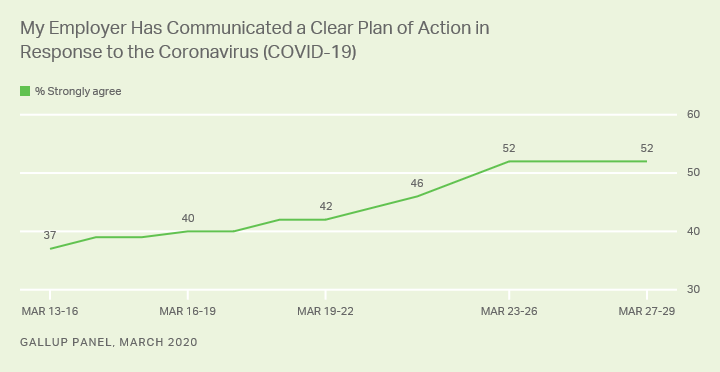Story Highlights
- Gallup is measuring unprecedented disruption due to COVID-19
- We're also tracking how leaders are meeting the needs of followers
- Organizations can use five key elements to gauge their progress
More than three weeks into the pandemic-driven cascade of cancelations, closings and social distancing, U.S. workplaces are experiencing unprecedented disruption -- and it's measurable.
Here's what has changed in a stunningly short period of time (comparing Gallup Panel surveys conducted March 13-16 vs. March 27-29):
- The percentage of full-time employees who say COVID-19 has disrupted their life "a great deal" or "a fair amount" has jumped from 58% to 81%.
- 40% of U.S. employees say their employer has frozen hiring, and 33% say their employer has reduced hours or shifts because of COVID-19 -- up from 33% and 27%, respectively.
- The percentage of full-time employees working from home because of COVID-19 closures has increased from 33% to 61%.
- The percentage of parents working full time who have kept their kids home from school because of COVID-19 has increased from less than half (44%) to everyone (100%).
The combined effects of frightening uncertainty about physical and financial health in the near future and the pressures of required self-isolation have led to record levels of stress and worry that far surpass those recorded in past years. Compared with 2019, reports of daily worry have increased from 37% to 60% among the full-time working population. Daily stress has increased from 48% to 65%.
The Employer Response to COVID-19
Record-level disruption means employers have had to respond at a record-level pace -- recrafting remote jobs on the fly while, as much as possible, easing employees' concerns to reduce worry and stress.
So, how are employers doing?
On March 23, Gallup reported on five key elements that organizations can influence and measure to gauge their progress in meeting what we've discovered are the four needs of followers -- trust, compassion, stability and hope. We have been tracking how well organizations are doing on each of these five elements.
Leadership Has a Clear Plan
Organizations have improved in the clarity of their communication to employees -- 52% of employees strongly agree that their employer has communicated a clear plan of action in response to the coronavirus, an improvement of 15 percentage points from mid-March.

Employees look to leadership to provide direction and stability. While there has been improvement, many leaders are still keeping their employees in the dark.
Feel Well Prepared to Do My Job
There's a lack of progress in this area. In the March 13-16 Gallup Panel survey, 55% of full-time workers strongly agreed that they felt well prepared to do their job. That figure has not improved in the past two weeks -- it was at 52% as of March 27-29.
Halting progress in this area is likely a result of the increased disruption of work in the past two weeks. Employers have had to design new remote jobs that didn't exist a few weeks ago. In times of uncertainty and disruption, Gallup meta-analytics have found that organizations should refocus on basic engagement elements: clarifying expectations, making sure employees have the materials and equipment they need, and reconfiguring jobs so that people can continue to do what they do best every day.
Also, it is urgent that leaders help people see how their work connects to the bigger-picture mission or purpose of the organization.
The percentage of full-time employees who say COVID-19 has disrupted their life "a great deal" or "a fair amount" has jumped from 58% to 81%.
Supervisor Keeps Me Informed
The percentage of full-time workers who strongly agree that their supervisor keeps them informed about what is going on in the organization has increased from 47% to 54%. The supervisor or manager is the key conduit to setting clear expectations, adjusting resources, helping each person feel connected and involved, creating accountability, and recognizing employees for their contributions.
It is urgent that leaders help people see how their work connects to the bigger-picture mission or purpose of the organization.
Organization Cares About My Wellbeing
With increases in worry and stress, as well as rising loneliness and boredom, the organization's role in sustaining wellbeing is more important than ever. And it is more complicated than ever with millions of kids at home and intersecting with their parents' work daily.
The percentage of full-time workers who strongly agree that their organization cares about their overall wellbeing has increased from 45% to 49%.
At a basic level, having thriving overall wellbeing and good experiences throughout the day, even in quarantine, starts with getting the basics of employee engagement right -- career wellbeing. Wellbeing is multidimensional and includes social, financial, community and physical elements as well.
Organizations can support employees' overall wellbeing as they adjust their policies, workplaces, incentives, recognition, virtual events and development programs to the temporary new normal. A key factor lies in equipping managers to individualize to each person's situation.
Social Distancing
The percentage of full-time workers "always" practicing social distancing has risen from 22% to 51%. Gallup analysis shows substantial increases in social distancing reported by Americans -- avoiding large crowds, changing travel plans and avoiding public places, for example. About two-thirds of Americans report completely or mostly isolating themselves -- but there is still plenty of room for improvement if the country is to flatten the COVID-19 curve by eliminating its growth rate.
Changes in social behavior are often driven by the influence of key participants in social networks. Employers play a critical role in this -- from the accommodations they make in how work gets done, to the statements they make about the importance of social distancing and its impact on society, to the behavior modeled by their leaders.
Get more resources for leading through disruption:
- Stay up to date with Gallup's COVID-19 analytics and advice.
- Learn more about the four needs of followers with the free webinar "What Employees Need From Leaders During a Crisis."





